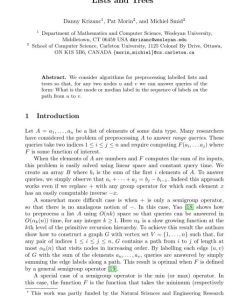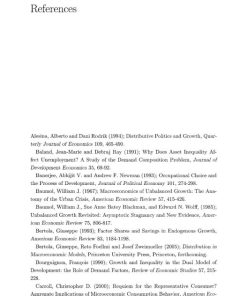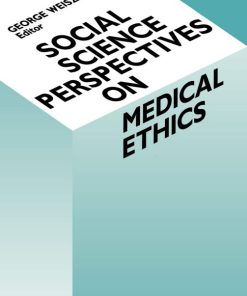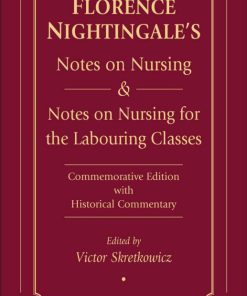Nursing Physician Control and the Medical Monopoly Historical Perspectives on Gendered Inequality in Roles Rights Range of Practice 1st Edition by Thetis Group, Joan Roberts ISBN 025333926X 9780253339263
$50.00 Original price was: $50.00.$25.00Current price is: $25.00.
Authors:Thetis M.Group, Joan I. Roberts , Author sort:Thetis M.Group, Joan I. Roberts
Nursing Physician Control and the Medical Monopoly Historical Perspectives on Gendered Inequality in Roles Rights Range of Practice 1st Edition by Thetis Group, Joan Roberts – Ebook PDF Instant Download/Delivery. 025333926X ,9780253339263
Full download Nursing Physician Control and the Medical Monopoly Historical Perspectives on Gendered Inequality in Roles Rights Range of Practice 1st Edition after payment

Product details:
ISBN 10: 025333926X
ISBN 13: 9780253339263
Author: Thetis Group, Joan Roberts
Nursing, Physician Control, and the Medical Monopoly traces the efforts by physicians over time to achieve a monopoly in healthcare, often by subordinating nurses―their only genuine competitors. Attempts by nurses to reform many aspects of healthcare have been repeatedly opposed by physicians whose primary interest has been to achieve total control of the healthcare “system,” often to the detriment of patients’ health and safety.
Thetis M. Group and Joan I. Roberts first review the activities of early women healers and nurses and examine nurse-physician relations from the early 1900s on. The sexist domination of nursing by medicine was neither haphazard nor accidental, but a structured and institutionalized phenomenon. Efforts by nurses to achieve greater autonomy were often blocked by hospital administrators and organized medicine. The consolidation of the medical monopoly during the 1920s and 1930s, along with the waning of feminism, led to the concretization of stereotyped gender roles in nursing and medicine. The growing unease in nurse-physician relations escalated from the 1940s to the 1960s; the growth and complexity of the healthcare industry, expanding scientific knowledge, and increasing specialization by physicians all created heavy demands on nurses.
Conflict between organized medicine and nursing entered a public, open phase in the late 1960s and 1970s, when medicine unilaterally created the physician’s assistant, countered by nursing’s development of the advanced nurse practitioner. But gender stereotypes remained central to nurse-physician relations in the 1980s and into the 1990s.
Finally, Group and Roberts examine the results of the medical monopoly, from the impact on patients’ health and safety, to the development of HMOs and the current overpriced, poorly coordinated, and fragmented healthcare system.
Nursing Physician Control and the Medical Monopoly Historical Perspectives on Gendered Inequality in Roles Rights Range of Practice 1st Edition Table of contents:
Chapter 1: Introduction to Nursing and Medicine
- Historical Overview of Nursing and Medicine
- The Development of Professional Nursing
- The Role of Physicians in Healthcare: A Historical Perspective
- The Gendered Origins of Nursing and Medicine
- Key Concepts: Professionalism, Authority, and Gender Inequality
Chapter 2: Early History of Medicine and Nursing
- The Evolution of Medicine in Ancient Civilizations
- Early Nursing Practices: From Religious Orders to Scientific Approaches
- The Role of Women in Early Nursing and Medical Practices
- Institutionalization of Medicine and Its Impact on Nursing
- The Birth of Professional Nursing in the 19th Century
Chapter 3: The Rise of the Medical Monopoly
- The Medical Profession and the Concept of Monopoly in Healthcare
- Professionalization of Medicine and Exclusion of Other Health Disciplines
- The Role of Gender in the Formation of the Medical Monopoly
- The Control of Medical Education and Licensing
- Impact of the Medical Monopoly on Nursing and Other Health Professions
Chapter 4: Gendered Inequality in Healthcare Professions
- Women’s Roles in Medicine and Nursing: Historical Challenges
- The Gender Divide: Nurses vs. Physicians
- Societal Expectations of Gender Roles in the Healthcare System
- Gender Discrimination and Its Effects on Professional Development
- The Evolution of Women’s Rights in Healthcare Professions
Chapter 5: Physician Control Over Nursing Roles and Practice
- The Development of Physician Authority in Healthcare Settings
- Nurses’ Roles Within the Hierarchical Medical Structure
- Legal and Institutional Constraints on Nursing Practice
- Physician-Nurse Dynamics and Conflict over Autonomy
- Case Studies of Physician Control in Nursing
Chapter 6: Nursing’s Struggle for Autonomy and Professional Recognition
- The Fight for Legal Rights and Practice Expansion in Nursing
- Key Figures in the Nursing Movement for Autonomy
- The Role of Nurse Leaders and Advocacy Organizations
- Expanding the Role of Nurses: Education and Licensing Reform
- The Intersection of Nursing Autonomy and Gender Equality
Chapter 7: Contemporary Gendered Dynamics in Healthcare Professions
- Modern Gender Inequality in Healthcare Roles and Pay Disparities
- The Influence of Gender on Medical and Nursing Authority Today
- Contemporary Challenges in Achieving Gender Equality in Medicine and Nursing
- The Role of Gender in Medical Decision-Making and Patient Care
- Gender Bias in Medical Research and Practice
Chapter 8: Legal and Ethical Considerations in Gendered Inequality
- The Legal Landscape of Nursing and Physician Control
- Ethical Dilemmas Related to Gendered Professional Inequality
- Gender Bias in Healthcare Policy and Regulation
- The Fight for Equal Rights and Recognition for Nurses
- Legal Precedents and Policy Changes for Gender Equality in Nursing
Chapter 9: Global Perspectives on Nursing and Physician Control
- Gendered Inequality in Nursing and Medicine Worldwide
- The Global Struggle for Equal Rights in Healthcare Professions
- International Case Studies of Nurse Autonomy and Gender Equity
- Cultural Differences in the Physician-Nurse Relationship
- Advancements in Gender Equality for Nurses in Global Health Settings
Chapter 10: The Future of Nursing, Physician Control, and Gender Equality
- Future Directions for Nursing and Medicine
- Changing Gender Dynamics in Healthcare Professions
- The Role of Education, Advocacy, and Legislation in Shaping the Future
- Building Collaborative Models Between Nurses and Physicians
- The Path Forward for Gender Equality and Professional Autonomy
People also search for Nursing Physician Control and the Medical Monopoly Historical Perspectives on Gendered Inequality in Roles Rights Range of Practice 1st Edition:
nursing theory for medication adherence
nursing theory medication administration
nursing responsibilities as it relates to controlled substance
a nurse practitioner’s right to practice is regulated under
You may also like…
eBook PDF
Nursing Perspectives on Quality of Life 1st Edition by Peter Draper 0415141699 9780415141697












